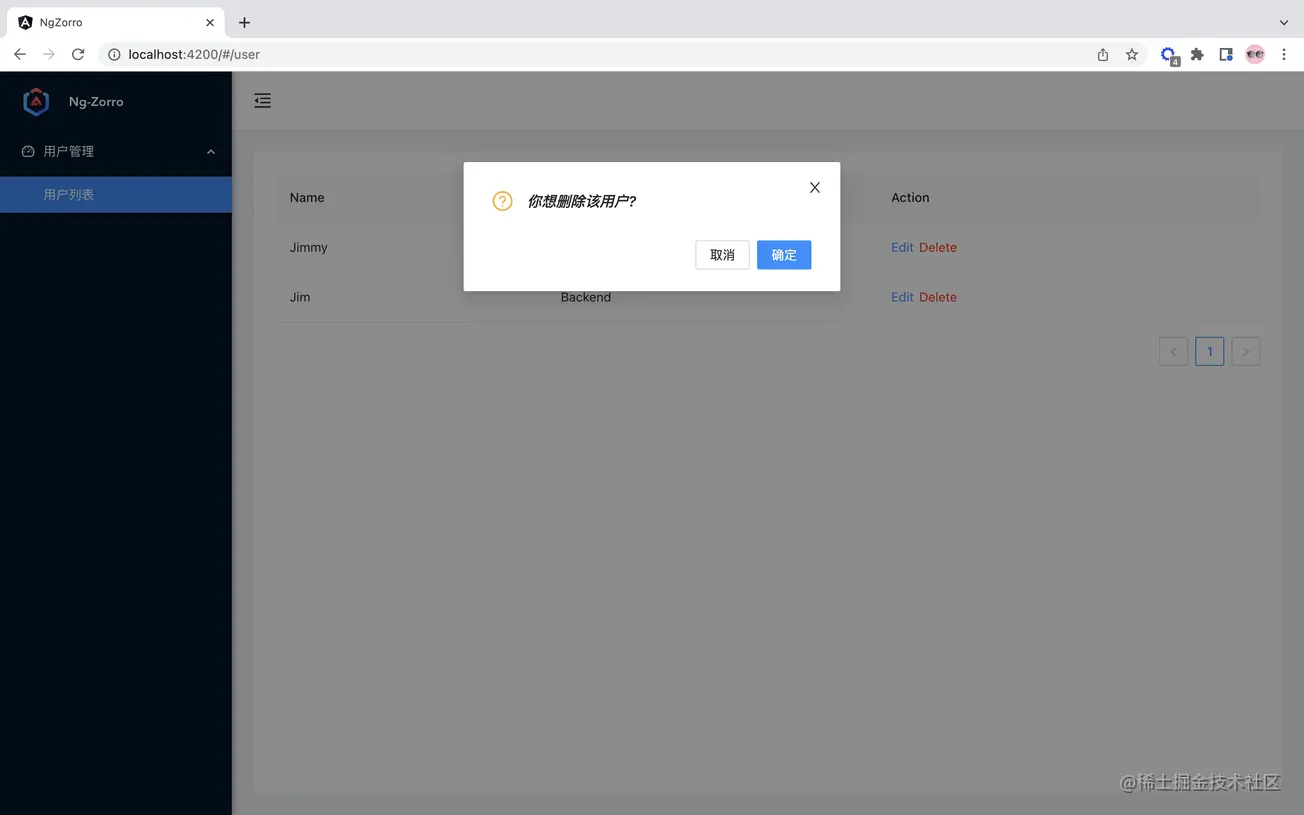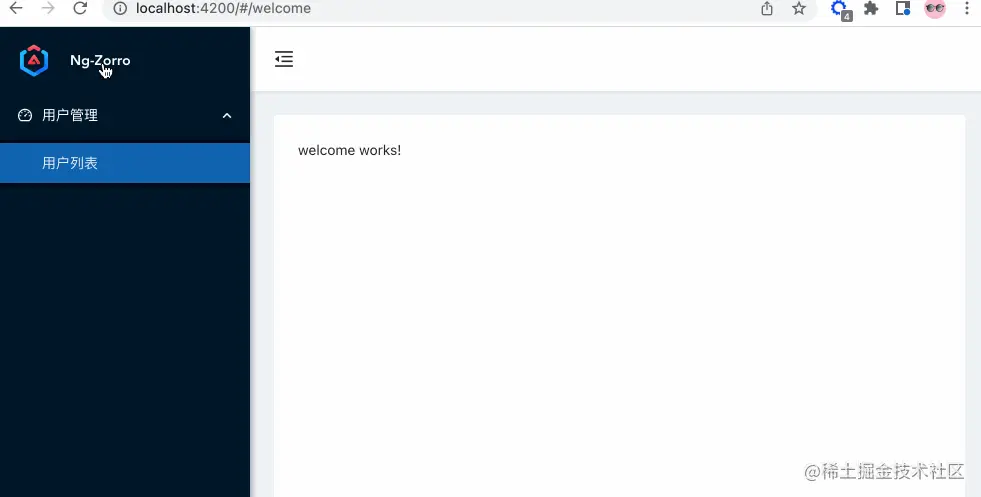Angular + NG-ZORRO quickly develop a backend system
This article will share with you a Angular practical experience to learn how to quickly develop a backend system using angualr combined with ng-zorro. I hope it will be helpful to everyone!

We have learned a lot about angular in the past few days. This time we have a small finished product.
angualr Combined with ng-zorro to develop a backend system quickly and standardizedly. [Related tutorial recommendations: "angular tutorial"]
System functions include the following:
- Welcome page
- User list
- User added
- User modified
- User deleted
All services use simulated data.
Let’s do it as we are told.
Combined with ng-zorro
##angular The more popular ui frameworks are:
- Angular Material officially designated UI framework
- NG-ZORRO, also known as Ant Design of Angular, the more popular domestic UI framework
Ant Design I believe people who do front-end development are familiar with it. So here we combine it with the NG-ZORRO framework. If you are familiar with Vue or React version of Ant Design, I believe you can connect seamlessly~

angular-cli to generate a project ng-zorro.
ng-zorro is very simple: enter the ng-zorro root directory and execute ng add ng-zorro-antd That is Can.
Of course you can also executeCombinednpm install ng-zorro-antd
to add, but it is not recommended.
ng-zorro After completion, we run the projectnpm run start, you will be inhttp://localhost:4200 page, see the content below.

Not Bad, Bro.
Configure routing
We changed it tohash routing and added user routing. The scaffolding has done it for us, we only need to make some minor modifications.
- First add the page
user
User's list page, useng-zorrointableComponent - The user's new and modified pages can share the same page, using the
form
component## inng-zorro #The page deletion function directly uses the pop-up prompt, using the - modal
component in
ng-zorro Introduce the - ng-zorro
component as needed
Adjust the routing file - According to the idea, we have to
introduces: <div class="code" style="position:relative; padding:0px; margin:0px;"><pre class='brush:php;toolbar:false;'>// app.module.ts
import { ReactiveFormsModule } from &#39;@angular/forms&#39;;
import { NzTableModule } from &#39;ng-zorro-antd/table&#39;;
import { NzModalModule } from &#39;ng-zorro-antd/modal&#39;;
import { NzButtonModule } from &#39;ng-zorro-antd/button&#39;;
import { NzFormModule } from &#39;ng-zorro-antd/form&#39;;
import { NzInputModule } from &#39;ng-zorro-antd/input&#39;;
// ...
imports: [ // 是在 imports 中添加,而不是 declarations 中声明
NzTableModule,
NzModalModule,
NzButtonModule,
NzFormModule,
ReactiveFormsModule,
NzInputModule
],</pre><div class="contentsignin">Copy after login</div></div> Simple and easy to understand principle, we do not use
here for nesting of routes: <div class="code" style="position:relative; padding:0px; margin:0px;"><pre class='brush:php;toolbar:false;'>// app.routing.module.ts
import { NgModule } from &#39;@angular/core&#39;;
import { Routes, RouterModule, PreloadAllModules } from &#39;@angular/router&#39;;
import { WelcomeComponent } from &#39;./pages/welcome/welcome.component&#39;;
import { UserComponent } from &#39;./pages/user/user.component&#39;;
import { UserInfoComponent } from &#39;./pages/user/user-info/user-info.component&#39;;
// 相关的路由
const routes: Routes = [
{
path: &#39;&#39;,
pathMatch: &#39;full&#39;,
redirectTo: &#39;/welcome&#39;
},
{
path: &#39;welcome&#39;,
component: WelcomeComponent
},
{
path: &#39;user&#39;,
component: UserComponent
},
{
path: &#39;user/add&#39;,
component: UserInfoComponent
},
{
path: &#39;user/edit/:uuid&#39;,
component: UserInfoComponent
}
];
@NgModule({
imports: [RouterModule.forRoot(
routes,
{
useHash: true,// 使用 hash 模式
preloadingStrategy: PreloadAllModules
}
)],
exports: [RouterModule]
})
export class AppRoutingModule { }</pre><div class="contentsignin">Copy after login</div></div>
Change the menuThe menu generated using scaffolding does not match the functions we need to develop, let’s adjust it.
// app.component.html
<nz-layout class="app-layout">
<nz-sider class="menu-sidebar"
nzCollapsible
nzWidth="256px"
nzBreakpoint="md"
[(nzCollapsed)]="isCollapsed"
[nzTrigger]="null">
<div class="sidebar-logo">
<!-- 默认点击 logo 跳转到首页 -->
<a routerLink="/welcome">
<img src="/static/imghw/default1.png" data-src="https://ng.ant.design/assets/img/logo.svg" class="lazy" alt="logo">
<h1 id="Ng-Zorro">Ng-Zorro</h1>
</a>
</div>
<ul nz-menu nzTheme="dark" nzMode="inline" [nzInlineCollapsed]="isCollapsed">
<li nz-submenu nzOpen nzTitle="用户管理" nzIcon="dashboard">
<ul>
<li nz-menu-item nzMatchRouter>
<a routerLink="/user">用户列表</a>
</li>
</ul>
</li>
</ul>
</nz-sider>
<nz-layout>
<nz-header>
<div class="app-header">
<span class="header-trigger" (click)="isCollapsed = !isCollapsed">
<i class="trigger"
nz-icon
[nzType]="isCollapsed ? 'menu-unfold' : 'menu-fold'"
></i>
</span>
</div>
</nz-header>
<nz-content>
<div class="inner-content">
<router-outlet></router-outlet>
</div>
</nz-content>
</nz-layout>
</nz-layout>After replacing the above code, the basic skeleton obtained is as follows:

Complete user list Next, complete the skeleton of the user list. Because we use the
UI framework, it is extremely convenient for us to write:
// user.component.html
<nz-table #basicTable [nzData]="list">
<thead>
<tr>
<th>Name</th>
<th>Position</th>
<th>Action</th>
</tr>
</thead>
<tbody>
<!-- 对获取到的数据进行遍历 -->
<tr *ngFor="let data of basicTable.data">
<td>{{data.name}}</td>
<td>{{data.position}}</td>
<td>
<a style="color: #f00;">Delete</a>
</td>
</tr>
</tbody>
</nz-table>
folder user.json:<div class="code" style="position:relative; padding:0px; margin:0px;"><pre class='brush:php;toolbar:false;'>{
"users": [
{
"uuid": 1,
"name": "Jimmy",
"position": "Frontend"
},
{
"uuid": 2,
"name": "Jim",
"position": "Backend"
}
],
"environment": "development"
}</pre><div class="contentsignin">Copy after login</div></div> After writing the service, we called to get the user's data:
// user.component.ts
import { Component, OnInit } from '@angular/core';
import { UserService } from 'src/app/services/user.service';
@Component({
selector: 'app-user',
templateUrl: './user.component.html',
styleUrls: ['./user.component.scss']
})
export class UserComponent implements OnInit {
public list: any = []
constructor(
private readonly userService: UserService
) { }
ngOnInit(): void {
if(localStorage.getItem('users')) {
let obj = localStorage.getItem('users') || '{}'
this.list = JSON.parse(obj)
} else {
this.getList()
}
}
// 获取用户列表
getList() {
this.userService.getUserList().subscribe({
next: (data: any) => {
localStorage.setItem('users', JSON.stringify(data.users))
this.list = data.users
},
error: (error: any) => {
console.log(error)
}
})
}
}Because no back-end service is introduced, here we use
localstorage to record the status. After completing the above, we get the list information as follows:

us Simply create a form, which contains only two fields, namely
name and position. These two functions share a common form~We add in
:<div class="code" style="position:relative; padding:0px; margin:0px;"><pre class='brush:php;toolbar:false;'>// user-info.component.html
<form nz-form [formGroup]="validateForm" class="login-form" (ngSubmit)="submitForm()">
<nz-form-item>
<nz-form-control nzErrorTip="请输入用户名!">
<input type="text" nz-input formControlName="username" placeholder="请输入用户名" style="width: 160px;" />
</nz-form-control>
</nz-form-item>
<nz-form-item>
<nz-form-control nzErrorTip="请输入职位!">
<input type="text" nz-input formControlName="position" placeholder="请输入职位" style="width: 160px;"/>
</nz-form-control>
</nz-form-item>
<button nz-button class="login-form-button login-form-margin" [nzType]="&#39;primary&#39;">确认</button>
</form></pre><div class="contentsignin">Copy after login</div></div>The page looks like this:
然后就是逻辑的判断,进行添加或者是修改。如果是连接带上 uuid 的标识,就表示是编辑,show you the codes。
// user-info.component.ts
import { Component, OnInit } from '@angular/core';
import { FormBuilder, FormGroup, Validators } from '@angular/forms';
import { ActivatedRoute, ParamMap } from '@angular/router';
@Component({
selector: 'app-user-info',
templateUrl: './user-info.component.html',
styleUrls: ['./user-info.component.scss']
})
export class UserInfoComponent implements OnInit {
public isAdd: boolean = true;
public userInfo: any = []
public uuid: number = 0;
validateForm!: FormGroup;
constructor(
private fb: FormBuilder,
private route: ActivatedRoute,
) { }
ngOnInit(): void {
this.userInfo = JSON.parse(localStorage.getItem('users') || '[]')
this.route.paramMap.subscribe((params: ParamMap)=>{
this.uuid = parseInt(params.get('uuid') || '0')
})
// 是编辑状态,设置标志符
if(this.uuid) {
this.isAdd = false
}
if(this.isAdd) {
this.validateForm = this.fb.group({
username: [null, [Validators.required]],
position: [null, [Validators.required]]
});
} else {
let current = (this.userInfo.filter((item: any) => item.uuid === this.uuid))[0] || {}
// 信息回填
this.validateForm = this.fb.group({
username: [current.name, [Validators.required]],
position: [current.position, [Validators.required]]
})
}
}
submitForm() {
// 如果不符合提交,则报错
if(!this.validateForm.valid) {
Object.values(this.validateForm.controls).forEach((control: any) => {
if(control?.invalid) {
control?.markAsDirty();
control?.updateValueAndValidity({ onlySelf: true });
}
})
return
}
// 获取到表单的数据
const data = this.validateForm.value
// 新增用户
if(this.isAdd) {
let lastOne = (this.userInfo.length > 0 ? this.userInfo[this.userInfo.length-1] : {});
this.userInfo.push({
uuid: (lastOne.uuid ? (lastOne.uuid + 1) : 1),
name: data.username,
position: data.position
})
localStorage.setItem('users', JSON.stringify(this.userInfo))
} else { // 编辑用户,更新信息
let mapList = this.userInfo.map((item: any) => {
if(item.uuid === this.uuid) {
return {
uuid: this.uuid,
name: data.username,
position: data.position
}
}
return item
})
localStorage.setItem('users', JSON.stringify(mapList))
}
}
}我们先设定一个标志符 isAdd,默认是新建用户;当 uuid 存在的时候,将其设置为 false 值,表示是编辑的状态,对内容进行表单的回填。提交表单的操作也是按照该标志符进行判断。我们直接对 localStorage 的信息进行变更,以保证同步列表信息。
删除功能
我们引入模态对话框进行询问是否删除。
// user.component.ts
// 删除
delete(data: any) {
this.modal.confirm({
nzTitle: '<i>你想删除该用户?</i>',
nzOnOk: () => {
let users = JSON.parse(localStorage.getItem('users') || '[]');
let filterList = users.filter((item: any) => item.uuid !== data.uuid);
localStorage.setItem('users', JSON.stringify(filterList));
this.list = filterList
}
});
}
我们找到删除的数据,将其剔除,重新缓存新的用户数据,并更新 table 的用户列表数据。
So,到此为止,我们顺利完成了一个简单的项目。我们用 Gif 图整体来看看。

【完】
更多编程相关知识,请访问:编程入门!!
The above is the detailed content of Angular + NG-ZORRO quickly develop a backend system. For more information, please follow other related articles on the PHP Chinese website!

Hot AI Tools

Undresser.AI Undress
AI-powered app for creating realistic nude photos

AI Clothes Remover
Online AI tool for removing clothes from photos.

Undress AI Tool
Undress images for free

Clothoff.io
AI clothes remover

AI Hentai Generator
Generate AI Hentai for free.

Hot Article

Hot Tools

Notepad++7.3.1
Easy-to-use and free code editor

SublimeText3 Chinese version
Chinese version, very easy to use

Zend Studio 13.0.1
Powerful PHP integrated development environment

Dreamweaver CS6
Visual web development tools

SublimeText3 Mac version
God-level code editing software (SublimeText3)

Hot Topics
 Let's talk about metadata and decorators in Angular
Feb 28, 2022 am 11:10 AM
Let's talk about metadata and decorators in Angular
Feb 28, 2022 am 11:10 AM
This article continues the learning of Angular, takes you to understand the metadata and decorators in Angular, and briefly understands their usage. I hope it will be helpful to everyone!
 How to install Angular on Ubuntu 24.04
Mar 23, 2024 pm 12:20 PM
How to install Angular on Ubuntu 24.04
Mar 23, 2024 pm 12:20 PM
Angular.js is a freely accessible JavaScript platform for creating dynamic applications. It allows you to express various aspects of your application quickly and clearly by extending the syntax of HTML as a template language. Angular.js provides a range of tools to help you write, update and test your code. Additionally, it provides many features such as routing and form management. This guide will discuss how to install Angular on Ubuntu24. First, you need to install Node.js. Node.js is a JavaScript running environment based on the ChromeV8 engine that allows you to run JavaScript code on the server side. To be in Ub
 Detailed explanation of angular learning state manager NgRx
May 25, 2022 am 11:01 AM
Detailed explanation of angular learning state manager NgRx
May 25, 2022 am 11:01 AM
This article will give you an in-depth understanding of Angular's state manager NgRx and introduce how to use NgRx. I hope it will be helpful to you!
 A brief analysis of how to use monaco-editor in angular
Oct 17, 2022 pm 08:04 PM
A brief analysis of how to use monaco-editor in angular
Oct 17, 2022 pm 08:04 PM
How to use monaco-editor in angular? The following article records the use of monaco-editor in angular that was used in a recent business. I hope it will be helpful to everyone!
 An article exploring server-side rendering (SSR) in Angular
Dec 27, 2022 pm 07:24 PM
An article exploring server-side rendering (SSR) in Angular
Dec 27, 2022 pm 07:24 PM
Do you know Angular Universal? It can help the website provide better SEO support!
 Angular + NG-ZORRO quickly develop a backend system
Apr 21, 2022 am 10:45 AM
Angular + NG-ZORRO quickly develop a backend system
Apr 21, 2022 am 10:45 AM
This article will share with you an Angular practical experience and learn how to quickly develop a backend system using angualr combined with ng-zorro. I hope it will be helpful to everyone!
 What should I do if the project is too big? How to split Angular projects reasonably?
Jul 26, 2022 pm 07:18 PM
What should I do if the project is too big? How to split Angular projects reasonably?
Jul 26, 2022 pm 07:18 PM
The Angular project is too large, how to split it reasonably? The following article will introduce to you how to reasonably split Angular projects. I hope it will be helpful to you!
 Let's talk about how to customize the angular-datetime-picker format
Sep 08, 2022 pm 08:29 PM
Let's talk about how to customize the angular-datetime-picker format
Sep 08, 2022 pm 08:29 PM
How to customize the angular-datetime-picker format? The following article talks about how to customize the format. I hope it will be helpful to everyone!







